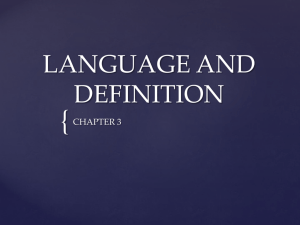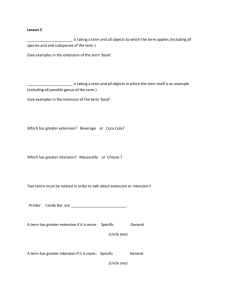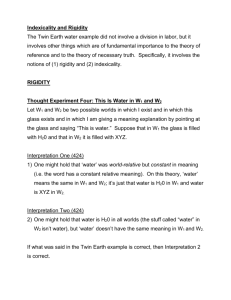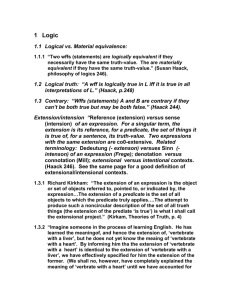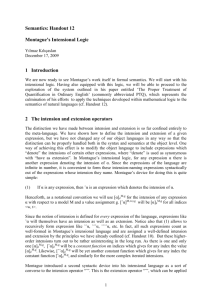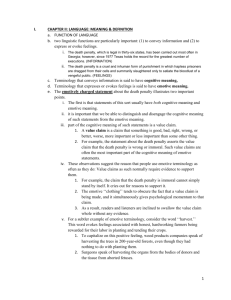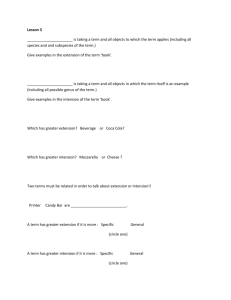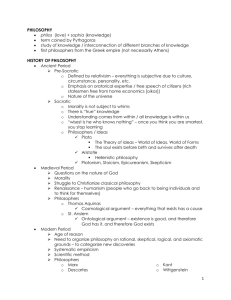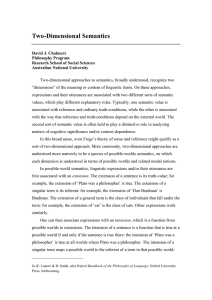Thought and Language - Where can my students do assignments
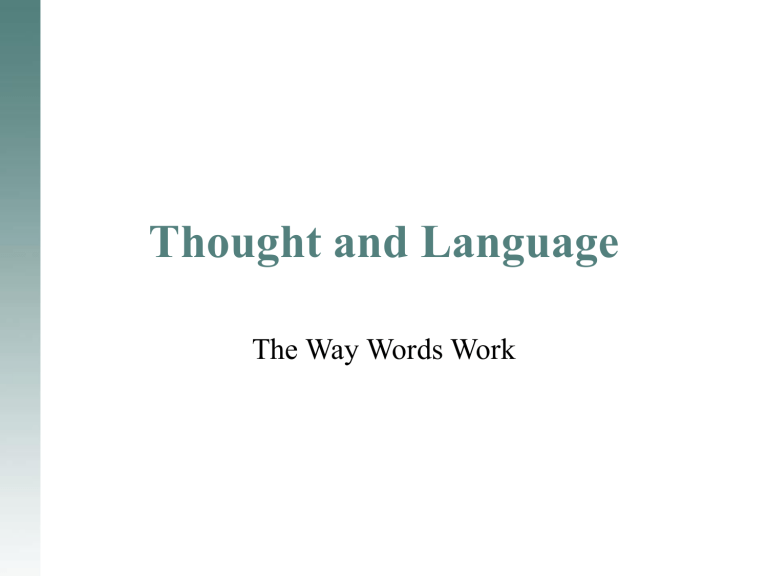
Thought and Language
The Way Words Work
Intension and Extension
• Intension refers to the general properties of a word, the qualities possessed in common by all objects that the term covers. It refers to the distinguishing traits or features by virtue of which a word applies to particular things. For example, all objects called “trees” must be woody perennial plants with a long main stem and branches because that is the intensional meaning of the word “tree.” Anything that we call a tree must have these characteristics or we are using the word incorrectly.
• When we don’t know the meaning of a word and look it up in the dictionary, the intension of the word is usually listed.
Intension and Extension II
• The intension of a general term is the set of attributes shared by all and only those objects to which the term refers. These attributes constitute the intensional meaning of the term; they provide the criteria for deciding whether an object falls within the extension of a term. We know the meaning of a term in this sense without knowing all the objects to which it applies.
Intension and Extension III
• General terms have both an extension and an intension. The extension of a general term (also called the denotation of the term) is the collection of all the objects to which the term applies. The general term "planet" for example applies equally to Venus, Mars, Jupiter, and Earth. These objects, and all others to which the term may be correctly applied, constitute the extensional meaning of the term "planet." To say that all planets have elliptical orbits, is, in this sense, to assert that Mars has an elliptical orbit, and Venus has an elliptical orbit, and Jupiter has an elliptical orbit, and so on.
Intension and Extension IV
• When attributes are added to the intension of a term we say that the intension increases. In the following sequence of terms, the intension of each is included within the intension of the term following it: “person,” “person that is a student,” “person that is an IPFW student,” “person that is an IPFW student taking a logic class.” The intension of each is greater than the intension of those preceding it in the sequence; the terms are arranged in order of increasing intension. But if we turn to the extensions of those terms, we find the reverse to be the case. The extension of
“person” is greater than that of “person that is a student,” and so on, and the terms are arranged in order of decreasing extension.
Intension and Extension V
• Some logicians have been led to formulate a “law of inverse variation,” asserting that extension and intension always vary inversely. This is not always correct. Copi points out that we could construct a series of terms in order of increasing intension, where the extension does not increase but remains the same. Consider this series: “living person,” “living person weighing less than ten thousand pounds,” “living person weighing less than ten thousand pounds and less than a million years old, and so forth. These terms are clearly in order of increasing intension, but the extension of them is the same.
Intension and Extension VI
• Instead of the law of inverse variation, the correct law asserts that, if terms are arranged in order of increasing intension, their extensions will be in non-increasing order; that is, if the extensions vary, they will vary inversely with the intensions.
• Some extensions, such as mermaids, are empty.
Sometimes, as in the case of “mermaid,” there are no real objects to which the word applies.
Nevertheless, we know how to use the word because of its intensional meaning.
Intension and Extension VII
• Using our distinction between intension and extension, fallacious aguments that play upon tha ambiguity of the term “meaning” may be exposed. For example:
– The word “God” is not meaningless; therefore it has a meaning. But by definition, the word “God” means a being who is all-powerful and supremely good.
Therefore that all-powerful and supremely good being,
God, must exist.
– The equivocation is on the words “meaning” and
“meaningless,” which refers in one sense to the intension, and in another sense to the extension, of the same term. The word “God” is not meaningless, and so there is an intension that has it’s meaning. But it does not follow from the fact that a term has an intension that it denotes any existent thing.
Extensional Definitions
• A term’s extension is the complete list of the items, cases and so forth to which you could correctly apply the term. That means that the denotative definition of a term is the statement of its extension. If you define extensionally, then you list everything to which the term applies.
• Since virtually everything we run into can be seen as an example of many different classifications, these partial enumerations (which identify individual by individual) always seem to be subject to multiple interpretations.
• Sometimes this sort of confusion can be minimized by listing groups of things instead of individuals. For example, we might define “vertebrate” to mean amphibians and birds and fishes and mammal and reptiles.
Extensional Definitions II
• A definition by subclass assigns a meaning to a term by naming subclasses of the class denoted by the term. Such a definition, too, may be either partial or complete, depending on whether the subclass named, when taken together, include all the members of the class or only some of them.
Some more examples:
• “Tree” means pine, oak, maple, and the like.
• “Dog” means Cocker Spaniel, German Shepard,
Australian Sheepdog and the like.
• “Fictional work” means either a poem, play, a novel, or a short story.
• The first two definitions are partial, the third is complete.
Extensional Definitions III
• A special kind of definition by example is the ostensive or demonstrative definition . Instead of naming or describing the objects denoted by the term being defined, an ostensive definition refers to the examples by means of pointing, or by some other gesture. Ostensive definitions are invariably ambiguous, however, because to point to an object is also to point to a part of it, or to any of its attributes.
Extensional Definitions IV
• So an extensional definition is showing some or all members of a set. The alphabet is:
{a,b,c,d,e,f,g,h,I,j,k,l,m,n,o,p,q,r,s,t,u,v,w,x,y,z}
• An ostensive definition might be:
Extensional Definitions V
• Quasi-ostensive definitions attempt to resolve this ambiguity by adding a descriptive phrase to the definiens . But this presupposes a prior understanding of the descriptive phrase, defeating the purpose of the ostensive definition.
Extensional Definitions VI
• Extensional definitions have serious shortcomings.
First, as noted in the preceding section, extensional definitions fail to distinguish between two terms that have the same denotation
(extension) but different intensions.
• A classic example is 'the morning star' and 'the evening star'; both of which refer to the same thing, the planet 'Venus', but the sense of 'morning star' and 'evening star' is not the same.
Extensional Definitions VII
• Second, very few terms can have their extensions completely enumerated, so extensional definitions must generally be restricted to partial enumerations.
• For example, all natural numbers would be infinite.
Extensional Definitions VIII
• Third, any given object has many attributes and is therefore included in the extension of many different general terms. So any object listed as an example of a term in an extensional definition will also be an example of some other term and cannot help us distinguish the meanings of those terms.
• Suppose someone we're asked to define "movie star" and responded like this:
“Well, there is Tom Cruise, Eddie Murphy, Julia
Roberts and Will Smith.” They are all movie stars, but they are also all humans, all entertainers, and so forth.
Intensional Definition
• The word ‘intension’ may seem strange. If so it is probably because you are confusing it with its homonym (same sounding word) intention.
“Intention’ means, roughly, purpose, goal, or, end;
‘intension’ means the sum total of the properties shared by all and only things identified by a specific term. For philosophers, the term connotation is often used as if it were synonymous with intension. Some confusion may occur because ‘connotation’ is also sometimes used to mean the total significance of a term. As we already learned, ‘connotation’ is sometimes used to mean the emotive intent alone. To avoid accidental confusion of terms, they choose to use
‘intension’ rather than connotation.’
Intensional Definitions II
• The intension of a term consists of the attributes shared by all the objects denoted by the term, and shared only by those objects. To develop useful intensional definitions, however, we need to distinguish three senses of intension: subjective, objective, and conventional.
• The subjective intension of a general term is the set of all attributes that a speaker or writer believes to be possessed by objects denoted by that term. It is an individual's private understanding different from individual to individual and even from time to time for the same individual. The purpose of definitions, however, is to reveal the public, not the private, meanings of words.
Intensional Definitions III
• The objective intension of a general term is the total set of characteristics shared by the objects in the term's extension. But one would have to be allknowing to know all the attributes shared by a set of objects. And some attributes, although part of the objective intension of a term, may be obscure and irrelevant to most people who use the term.
Intensional Definitions IV
• The conventional intension of a general term consists of the commonly understood attributes of the objects it denotes, the conventionally agreed upon criteria we use in deciding, about any object, whether it is part of the term's extension. For the purposes of definition, this is the most important sense of-and what is generally meant byintension.
Connotation
•
Connotation refers to the emotional associations surrounding a word, its overtones or colorations that affect our feelings and attitudes.
• The explicit meaning of a word is one thing; the way it resonates within us is quite another, and that is connotation.
• In shaping attitudes the choice of words matter a great deal because of their connotative dimension. Bertrand Russell recognized this when he declined “firm” as “I am firm, you are obstinate, he is stubborn (and they are pigheaded).”
Euphemisms and Dysphemisms
•
Euphemisms are words with favorable or agreeable connotations, from the Greek eu-,
“good”, and pheme,
“speech.”
• A government is likely to pay a price for initiating a
“revenue enhancement”, but voters will be even quicker to respond to a tax hike.
• The opposite of a euphemism is a dysphemism.
Dysphemisms are used to produce a negative effect on a listener’s or reader’s attitude toward something or to tone down the positive associations it may have.
– “Isn’t the real reason the House of Representatives won’t render an impartial finding in any impeachment hearings that it has become a snake pit war room?”
“Snake pit and war room”are dysphemisms.
Moore and Parker: “Once you’re familiar with the ways slanting devices are used to try and influence us, you may be tempted to dismiss a claim or argument just because it contains strongly slanted language. But true claims as well as false ones, good reasoning as well as bad, can be couched in such language. Remember that the slanting itself gives us no reason to accept a position on an issue; that doesn’t mean that there are no such reasons.”
Connotations Revisited
• Select the word with the appropriate connotation to fill the blanks in this sentence:
(Divorced, unmarried) man ________ (past his prime, in his golden years) seeks relationship with a _______ (mature, over the hill) woman who is sensitive and __________ (independent, wealthy).
Vagueness
• Vague words or expressions lack clarity and distinctness, so that we don’t know whether they apply in a given case.
The limits of their application are fuzzy, and we are uncertain about what they include and exclude. Almost all words are vague to some extent, and in most cases this does not interfere with their meaning. Language is labeled vague only when it is unnecessarily imprecise, when the intension does not allow us to identify the extension. Then we criticize usage and vagueness becomes a charge.
• For example, suppose we ask a used car salesperson how much a car costs and we are told it’s a bargain, a very good deal, less expensive than we might think, priced to move, sure to save us money, and so forth. Because the car salesperson is not giving us a price, he or she is probably trying to make us think that that the car is cheaper than it really is; the vagueness is deliberate and meant to trick us.
Vagueness II
• On the other hand, the question “How much do you love me?” cannot be answered in numbers. Replies such as “as much as you deserve” or “not wisely but too well” are perfectly appropriate.
• If we want to measure how happy a person is, we are demanding what Aristotle called greater exactitude than the subject matter will allow.
• Vagueness is not always negative.
– “You must not know too much, or be too precise or scientific about birds and trees and flowers and watercraft; a certain free margin, and even vagueness – perhaps ignorance, credulity – helps your enjoyment of these things.” – Walt Whitman
Vagueness III
• In some contexts, of course, it becomes extremely important to reduce the vagueness of words as much as possible. If food stamps are offered to the poor, defining who exactly is “poor” can make a significant difference in people’s lives.
Ambiguity
• In ambiguity a word contains several meanings, and we are uncertain which one is meant. We are confused about the word, phrase, sentence, or passage because it can be understood in more than one sense.
• One traditional distinction that is made among types of ambiguity is between semantic and syntactic forms. Semantic ambiguity has to do with the multiple meanings of a word as it appears in a sentence, either once or twice. To take a couple of light examples, “Our druggists dispense with accuracy; “Bikinis now sold for a ridiculous figure.”
Ambiguity II
• Semantic ambiguity can be more serious, though. The Second
Amendment to the Constitution states, “ a well-regulated militia being necessary to the security of a free state, the right of the people to keep and bear arms shall not be infringed.” Does this mean that only
“militia” such as the National Guard are allowed to have arms, or that every citizen has the right to own a gun ( and all gun control laws are unconstitutional)? Serious debate has occurred as different people interpret the Second Amendment in different ways.
Syntactic Ambiguity
•
Syntactic ambiguity occurs when the grammatical arrangement of words makes the meaning of a sentence unclear. The meaning of each word may be clear, but we cannot understand the overall sense. Here are a few examples:
• “Eat here and get gas.”
• “Save soap and waste paper” (a World War II slogan).
• If you think are waitresses are rude, you should see our manager.
Semantic Ambiguity and accent
• Under the broad category of semantic ambiguity the phenomenon of accent should be mentioned. Here ambiguity occurs because it is unclear which word in a sentence is being accented or emphasized.
• A defense lawyer once asked a coroner, “How many autopsies have you performed on dead bodies?” He replied, “All of my autopsies were on dead bodies.” The attorney wanted to know the number of autopsies that had been performed, and the coroner assumed that he was asking whether all of his autopsies had been done on corpses. The misunderstanding occurred because different parts of the question were stressed.
